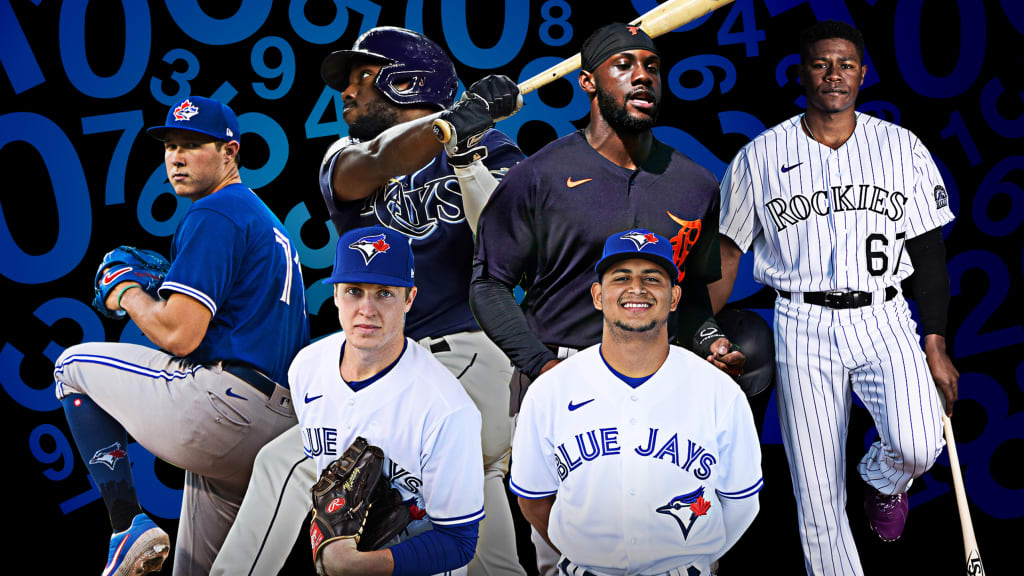
After a barren winter, new Statcast numbers can feel like an absolute feast.
The return of Cactus and Grapefruit League play has brought new opportunities to dive into performance and evaluate where players stand heading into the 2021 season. That is especially true of prospects, some of whom the public hasn't seen since the end of the 2019 Minor League campaign.
On Tuesday, Statcast data became publicly searchable for Spring Training games that have happened so far. To celebrate, here is a quick dive with prospects who led in some of the more prominent advanced-metric categories as of Monday's slate of games. Note that these are only for contests with Statcast data available. Sadly, neither Bobby Witt Jr.'s 484-foot home run nor Hunter Greene's 103 mph fastball qualify since Statcast wasn't at either game.
It's true that these come over a small early sample, but they at least illustrate what is possible for the tools of each prospect mentioned. And what is prospect evaluation if not looking at what is possible?
Average exit velocity (min. five batted balls)
Randy Arozarena, OF, Rays: 99.0 mph -- The results on Arozarena's stat sheet are far cries from the last time the baseball world saw him dominate the entire 2020 postseason. MLB Pipeline's No. 34 overall prospect opened 2-for-10 through his first four Grapefruit League games. Let this provide a lot more optimism. The right-handed slugger has put five balls into play in front of Statcast. Three of those five have come with exit velocities above 100 mph. None have come lower than 88.7 mph. In essence, Arozarena is still making tons of hard contact; he just has yet to put the ball in the air with the same regularity that helped him hit 10 homers in 20 playoff games last fall. (See below for a single with an exit velocity of 102 mph from March 4.) The only Statcast-measured batted ball from him this spring that wasn't on the ground was a popout to short. Expect the rest of the power to come in time, and take plenty of solace in the more advanced metrics.
Home run distance
Jameson Hannah, OF, Rockies: 417 feet -- You can't even claim the Coors effect here in Spring Training. The Rockies are getting their first full viewing of Hannah this spring after he came over from the Reds along with Robert Stephenson in a November deal that sent Jeff Hoffman and Case Williams the other way. Power is far from Hannah's best tool. The 5-foot-9 outfielder can show promising bat speed from the left side, but he finished with only two homers in 110 games at Class A Advanced in 2019. A big issue was that 55.4 percent of his batted balls were on the ground that season. As he showed below on Monday against the Reds, Hannah can translate that bat speed to balls beyond the fence if he can elevate the ball more going forward. A dinger like this one to deep right-center certainly helps make a solid first impression. Hannah is 3-for-4 over his first five Cactus League games this spring.
Average fastball velocity (min. 10 pitches)
Blue Jays RHP Nate Pearson, 98.4 mph -- Was there any doubt? MLB Pipeline's No. 10 overall prospect is known to pump plenty of gas, and that didn't change in his March 1 start against the Pirates. Pearson threw heaters on 21 of his 28 pitches and touched as high as 99.9 on the Statcast radar gun. Including last year's time in the Majors, that would be tied for his sixth-hardest-thrown pitch measured by Statcast so far. Unfortunately, it will be a while longer until we see the 6-foot-6 right-hander pumping gas again. He suffered a Grade 1 strain of his right groin in that one Grapefruit League appearance, and the Blue Jays did not have an immediate timetable for the righty's return. He extended his long-toss program to 120 feet this week, so there is optimism on that front. Getting Pearson's 80-grade heater in the rotation would be a big piece of helping Toronto track down New York and Tampa Bay in the AL East. (Speaking of the AL East, Yankees right-hander Albert Abreu has the highest velocity on a single fastball so far this spring at 100.4 mph.)
Average fastball and curveball spin rates (min. 10 pitches)
Blue Jays RHP Joey Murray -- Yes, Murray is tops in both categories, making the 24-year-old right-hander someone worth following in the weeks leading up to Opening Day. Murray's fastball has averaged 2,706 rpm (fourth-best this spring) while his curve is tops among all Spring Training pitchers at 3,105 rpm. The sample remains small; Murray has thrown only 24 fastballs and 10 curves, but this lines up with previous reports on the Toronto hurler's stuff. The 2018 eighth-rounder gets great extension from his 6-foot-2 frame, and the spin on the fastball makes it play up significantly despite averaging only 90.8 mph this spring because it's so difficult for hitters to pick up. Add in a high-spin curve, and it's not hard to see how Murray fanned 169 in 137 1/3 innings across two Class A levels and Double-A in 2019. The Jays want to keep him as a starter, but these two pitches alone could make him useful out of the Major League bullpen quickly.
Catcher arm strength
Blue Jays C Gabriel Moreno, 81.1 mph -- Make it a trio of Toronto prospects that Statcast has already shined on in 2021. There has been plenty of attention paid to Blue Jays catching prospect Alejandro Kirk coming off his Major League stint last season, but Moreno has tried to make the most of his own opportunities in Spring Training looks. One such chance came Sunday when Tigers outfielder JaCoby Jones attempted to steal second base. Moreno's pop time of 2.01 was on the average side, but his throw that measured at 81.1 mph was better. (Jones still successfully swiped second.) That one toss was equal to the Major League-best average catcher arm strength put up by Brewers backstop Manny Piña last season. Moreno, who is entering only his age-21 season, draws strong reviews for his athleticism that can help with his work behind the plate, and it was on display here.
Home-to-first speed
Tigers OF Akil Baddoo, 4.05 seconds -- The Tigers took Baddoo in last December's Rule 5 Draft, hoping his above-average speed could keep him on the Major League roster for a full season. So far so good in that department. Baddoo's sprint from home to first on a bouncing ball to shortstop on March 1 against the Yankees was the third-fastest measured by Statcast this spring and tops among prospects. Note in the video below how close a play it is at first base, despite how quickly the ball reaches short. To put the 4.05 into better context, it was between the average run times established by noted speedsters and fellow left-handed hitters Shohei Ohtani (4.04) and Kevin Kiermaier (4.06). Furthermore, Baddoo's sprint speed on the play was 30.3 ft/s, a smidge above the elite threshold of 30 ft/s. The former Twins prospect has gotten off to a solid start elsewhere as well, going 4-for-11 (.364) with a double and five walks. That, along with flashes of this elite-level speed, will force Baddoo's Rule 5 issue when the Tigers have to make some hard decisions toward the end of camp.


